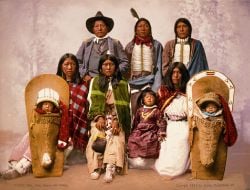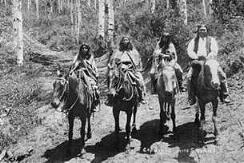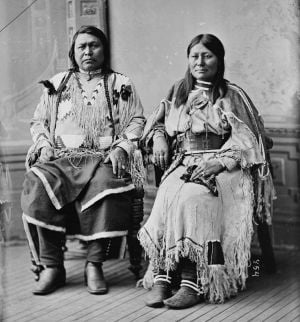Ute
| Ute |
|---|
Chief Severo and family, ca. 1899 |
| Total population |
| 4,800[1]–10,000[2] |
| Regions with significant populations |
| United States (Utah, Colorado, New Mexico) |
| Languages |
| English, Ute |
| Religions |
| Christianity, other |
| Related ethnic groups |
| other Numic peoples |
The Ute (/juːt/; "yoot"), meaning "high up" or "land of the sun," are American Indians now living primarily in Utah and Colorado. Their territory extended from the southern Rocky Mountains as far west as the Sevier River in present-day Utah, to which they gave their name. Today there are three Ute tribal reservations: Uintah-Ouray in northeastern Utah, Southern Ute, and Ute Mountain — both in southwestern Colorado.
The Ute were reputed to be war-like, especially when they acquired horses, becoming wide-ranging raiders and traders, and their war parties attacked the Spanish explorers. They also were involved in uprisings resisting white encroachment on their lands. However, they also allied themselves with the settlers, acting as guides and fighters against the Navajo and Apache. In particular, Chief Ouray sought reconciliation with the Americans, realizing that war would mean the end of his people.
The Ute were known for their crafts and their use of herbs for medicinal purposes. They also introduced peyote to Quanah Parker, who developed the Native American Church based on his visions of Christ after taking peyote.
Today, although they have only a fraction of their lands, the Southern Ute are financially successful. They combine business and tourist enterprises, including casinos, oil and natural gas operations, farming, arts and crafts. They maintain some of their traditional culture, and offer tours of their reservation showing rock art and performing traditional dances.
Name
"Ute" can be translated as "high land" or "land of the sun."[3] It is alternatively translated as "People of the mountains."[4]
Language
The native Ute language belongs to the Uto-Aztecan (Shoshone) family of languages and is a dialect of Southern Numic. However, most current Utes speak only English. Other groups with native Shoshonean dialects include the Bannocks, Comanches, Chemehuevi, Goshutes, Paiutes, and Shoshones.
History
Prior to the arrival of European settlers, the Utes occupied significant portions of what are today eastern Utah, western Colorado, and parts of New Mexico and Wyoming. The Utes were never a unified group; instead, the Utes consisted of numerous nomadic bands that maintained close associations with other neighboring groups. Some of the larger groups included the Moache, Capote, Uncompahgre, White River, Uintah, Pahvant, Timanogots, San Pitch, Moanumts, Sheberetch and Weeminuche. Unlike many other tribal groups in this region, there is no tradition or evidence of migration to the areas now known as Colorado and Utah — ancestors of the Ute appear to have occupied this area for at least a thousand years.
Contact with Spanish explorers
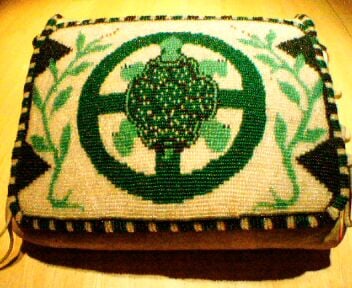
The Utes' first contact with Europeans was with early Spanish explorers in the 1630s. Horses were eventually obtained through trading with the Spanish colonists in New Mexico or theft from those settlements. The subsequent increase in mobility made possible by the horses was instrumental in changing aspects of Ute society in ways that paralleled the Plains Indian cultures of the Central U.S. This social upheaval resulted in various degrees of consolidation, political realignment, and tension among the various Ute groups.
The Utes were for the most part enemies of the Spanish and the conquered Pueblo towns, and engaged in a long series of wars, in some cases three-sided, with the Navajo, various other Apache tribes, and the Comanche, especially in the plains of eastern Colorado and northeastern New Mexico.
Contact with other European settlers
The Ute experience with European-American settlers is similar to that of many other Native American groups: competition, confrontation, and eventual coerced relocation to reservations. The Ute resisted encroachment on their land in two notable uprisings: the Walker War (1853–1854) and Black Hawk War (1865–1872) in Utah.
Over the years, several other skirmishes and incidents occurred between Utes and white gold-seekers and settlers in Utah and Colorado. These Ute "uprisings" were the result of friction between recently arrived Anglos and local Ute groups. At the same time, the Ute were allies of the United States in its wars with the Navajo and Apache to the south.
In 1863 when the United States army attacked the Navajo people, the Utes allied themselves with the Americans. Chief Ouray, an important leader of the Uncompahgre band of the Ute, was called "The White Man's Friend," as he sought reconciliation between peoples, understanding that war meant the end of his people.
A series of treaties established a small reservation in 1864 in NE Utah, and a reservation in 1868, which included the western third of modern Colorado, and that included land actually claimed by other tribes. This was whittled away until only the modern reservations are left: a large cession of land in 1873 transferred the gold-rich San Juan area, and was followed in 1879 by the loss of most of the remaining land.
Eventually, the various bands of Utes were consolidated onto three reservations. Several of these bands still maintain separate identities as part of the Ute tribal organizations. Although initially large and located in areas that white settlers deemed undesirable (occupying parts of Utah and most of western Colorado), the sizes of these reservations were repeatedly reduced by various government actions, encroachment by white settlers and mining interests. In the twentieth century, several U.S. federal court decisions restored portions of the original reservation land to the Ute Tribes' jurisdiction and awarded monetary compensations.
Culture
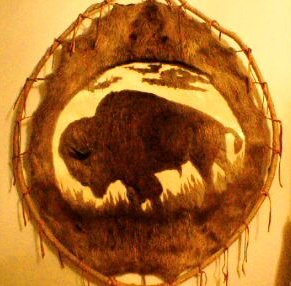
The Northern Ute, and in particular the Uncompahgre Ute from Colorado, are exceptional artisans and produced extraordinary examples of religious and ceremonial beadwork, unusual art forms, and cunningly designed and decorated weapons of war in their traditional culture. The Ute obtained glass beads and other trade items from early trading contact with Europeans and rapidly incorporated their use into religious, ceremonial, and spartan objects.
Uncompahgre and Northern Ute beadwork are some of the finest examples of Native American art produced in ancient and modern times by any of the Great Basin tribes.
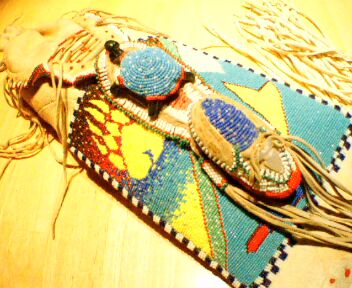
Like their Southern neighbors, the Dine' (Navajo), a large percentage of Northern Ute are members of the Native American Church and are active in peyote ceremonies. It was a Ute Medicine Man who first introduced Quanah Parker, founder of the Native American Church, to the use of peyote as a sacrament and healing medicine in the mid 1800s. The Ute have integrated peyote religion into their culture, with the resulting artistic and expressive influences pervading their art and rich cultural and ceremonial objects.
Traditional Ute healers still use peyote to treat infections, and a variety of other plants, including Elk Root (Echninacea angustifolia), Bear Root (Ligusticum porteri), and tobacco sage (Salvia dorii). There is evidence the Ute used peyote obtained through trade and other potent ceremonial plants used as entheogens since ancient times, such as the dried leaves of Larb (a species of Manzanita), Tobacco Sage (Salvia dorii) collected from the Escalante area (a mild hallucinogen when smoked), and the potent and narcotic White Uinta Water Lily. Tobacco Sage (Salvia dorii) was also brewed into a tea with Elk Root (Echinacea angustifolia), and the root of the Yellow Unita Water Lily and used to treat tumors and cancer. (The Yellow Unita Water Lily is a toxic plant, although small amounts of the root can be used to strengthen the heart muscle in people with heart ailments.) This preparation as been shown to reduce the effects of angiogenesis with certain cancers when administered as an admixture of these plants.
The Northern and Uncompahgre Ute were the only group of Indians known to create ceremonial pipes out of salmon alabaster, as well as a rare black pipestone found only in the creeks that border the Southeastern slopes of the Uinta Mountains in Utah and Colorado. Although Ute pipe styles are unique, they resemble more closely the styles of their Eastern neighbors from the Great Plains. The Black Pipestone is used not only to make ceremonial pipes, but also lethal war clubs that were used very efficiently from the back of a horse. The Ute have a religious aversion to handling thunderwood (wood from a tree struck by lightning) and believe that the thunder beings would strike down any Ute Indian that touched or handled such wood. This is also a Dine' (Navajo) belief. There is extensive evidence that contact between the two groups existed since ancient times.
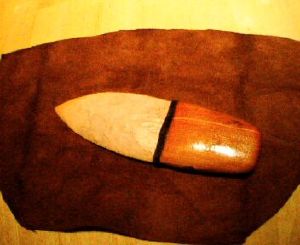

The Uncompahgre Ute Indians from Central Colorado are one of the first documented groups of people in the world known to utilize the effect of mechanoluminescence through the use of quartz crystals to generate light, likely hundreds of years before the modern world recognized the phenomenon. The Ute constructed special ceremonial rattles made from buffalo rawhide which they filled with clear quartz crystals collected from the mountains of Colorado and Utah. When the rattles were shaken at night during ceremonies, the friction and mechanical stress of the quartz crystals impacting together produced flashes of light which partly shone through the translucent buffalo hide. These rattles were believed to call spirits into Ute Ceremonies, and were considered extremely powerful religious objects.
Each spring the Utes hold their traditional Bear Dances. Origin of the Bear Dance can be traced back several centuries. Each year, a mid-summer fasting ceremony known as The Sun Dance is held; this ceremony has important spiritual significance to the Utes.
Ute mythology often refers to the rogue coyote as the prankster and the clown, but paradoxically also as the teacher of wisdom and morals passed down in oral tradition through the generations. The tricky old coyote is a crafty animal that was both feared and revered. In many tales the coyote goes from the trickster to the tricked, much as the Warner Brothers cartoon character the "Wile E. Coyote" who roams the desert plains and mountainous caverns of the American southwest, in which the Ute and other Native American tribes inhabited, constantly playing the role of the scheming predator who can never seem to catch up to his desired prey, the infamous "Road Runner."
Contemporary Ute
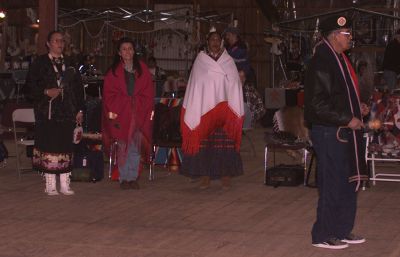
Present-day Utes occupy a small fraction of their former territories.
The largest tribe, the Northern Ute, lives on the Uintah-Ouray Reservation in northeastern Utah. It is the largest reservation in Utah. The Northern Ute Tribe began repurchasing former tribal lands following the Indian Reorganization Act of 1934. The 726,000 acre (2938 km²) Hill Creek Extension was returned to the tribe by the federal government in 1948. Court decisions in the 1980s granted the Northern Utes "legal jurisdiction" over three million acres (12,000 km²) of alienated reservation lands. Oil and natural gas discoveries on Ute land in Utah hold promise of increased living standards.
Several groups of Ute and Shoshone Indians were relocated to the Northern Ute reservation during the late 1800s and early 1900s, including the Northern Shoshone, Uinta, Uncompahgre Ute, Northern Ute, and Ouray Ute. The Northern Ute disfranchised the other Ute groups when they reorganized the Northern Ute Tribe during the mid 1900s, and gained control of the Uintah and Ouray Indian Reservation as a result. Lawsuits and litigation have been commonplace between the mixed blood Utes and the Northern Ute Tribe for rights to tribal enrollment and privileges. The Northern Ute Tribe has a 5/8 blood quantum requirement for tribal membership, and have been accused by the mixed blood Utes of disfranchising their rights to tribal lands and equal treatment. Most of the mixed blood Utes live on the reservation and have lived on land holdings owned by particular families since the Federal Government forced relocations in the late 1800s. The Mixed blood Utes have recently applied for Federal Recognition and are involved in litigation with the United States and the Northern Ute tribe.
The Southern Ute Indian Reservation is located in southwestern Colorado, with its capital at Ignacio. Today, the Southern Ute are the wealthiest of the tribes and claim financial assets approaching $2 billion.[5] Gambling, tourism, oil and gas, real estate leases, plus various off-reservation financial and business investments have contributed to their success. The Sky Ute Casino and its associated entertainment and tourist facilities, together with tribally-operated Lake Capote, draw tourists and host the Four Corners Motorcycle Rally each year.[6] The Ute operate KSUT, the major public radio station serving southwestern Colorado and the Four Corners.[7]

The Ute Mountain Ute are descendants of the Weminuche band who moved to the western end of the Southern Ute Reservation in 1897 (under the leadership of Chief Ignacio, for whom the eastern capital is named). The Ute Mountain Ute Indian Reservation is located near Towaoc, Colorado, and includes small sections of Utah and New Mexico. The Ute Mountain Tribal Park abuts Mesa Verde National Park and includes many Anasazi ruins. The White Mesa Community of Utah (near Blanding) is part of the Ute Mountain Ute Tribe, but is largely autonomous.
Gradual assimilation into American culture has presented both challenges and opportunities for the Utes. The current conditions of the Utes are similar to those of many Native Americans living on reservations. Cultural differences between the Utes and the rest of America have contributed to pockets of poverty, educational difficulties and societal marginalization, although the Southern Ute Tribe is financially successful.
Notes
- ↑ Ute-Southern Paiute Ethnologue. Retrieved May 7, 2022.
- ↑ American Indian, Alaska Native Tables from the Statistical Abstract of the United States: 2004–2005 US Census Bureau. Retrieved May 7, 2022.
- ↑ Southern Ute Museum of Northern Arizona. Retrieved May 7, 2022.
- ↑ Nancy McClure, The Arts and Culture of the Ute Indians – Points West Online Buffalo Bill Center of the West, March 20, 2016. Retrieved April 25, 2022.
- ↑ GF Private Equity Group Retrieved May 7, 2022.
- ↑ Four Corners Motorcycle Rally Retrieved May 7, 2022.
- ↑ KSUT Public Radio. Retrieved May 7, 2022.
ReferencesISBN links support NWE through referral fees
- Pettit, Jan. Utes: The Mountain People. Johnson Books, 1990. ISBN 1555660657
- Rockwell, Wilson. The Utes: A Forgotten People. Western Reflections Publishing Co., 1998. ISBN 1890437239
- Simmons, Virginia McConnell. The Ute Indians of Utah, Colorado, and New Mexico. University Press of Colorado, 2001. ISBN 0870816470
- Smith, Anne. Ute Tales. University of Utah Press, 1992. ISBN 0874804426
- Waldman, Carl. Encyclopedia of Native American Tribes. New York, NY: Checkmark Books, 2006. ISBN 978-0816062744
- Young, Richard K. The Ute Indians of Colorado in the Twentieth Century. University of Oklahoma Press, 1997. ISBN 0806129689
External links
All links retrieved May 3, 2023.
Credits
New World Encyclopedia writers and editors rewrote and completed the Wikipedia article in accordance with New World Encyclopedia standards. This article abides by terms of the Creative Commons CC-by-sa 3.0 License (CC-by-sa), which may be used and disseminated with proper attribution. Credit is due under the terms of this license that can reference both the New World Encyclopedia contributors and the selfless volunteer contributors of the Wikimedia Foundation. To cite this article click here for a list of acceptable citing formats.The history of earlier contributions by wikipedians is accessible to researchers here:
The history of this article since it was imported to New World Encyclopedia:
Note: Some restrictions may apply to use of individual images which are separately licensed.
